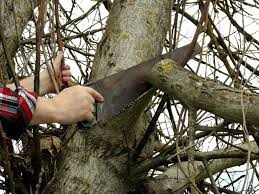
In general, walnut trees need less pruning than other fruit trees (apple, citrus etc.) However, the same rules of fruit trees pruning apply. In a few words, we prune (or “train”) young trees during their first or second year in order to determine their shape (crown skeleton). The shape is very important and can affect production quantity, quality and ease of harvesting or other farming activities. The most popular shape of walnut trees grown for nuts or wood is a central leader shape. It is consisted of a main leader and 3 secondary branches, which are formed at a height greater than 28-31 inches (70-80 cm) above the ground, so that mechanical harvesting will be facilitated. On the other hand, we prune mature trees in order to maintain their central leader shape, which promotes timber growth and nut production. We also prune mature trees in order to remove low hanging, broken, weak or diseased branches, and of course get rid of water sprouts. Branches that are rubbing together must also be removed. Old walnut growers used to apply a 33% rule when pruning mature trees. This means they did not leave any secondary branch reach a diameter greater than 1/3 (or 33%) of the main leader. However, pruning branches that have a diameter of 3 inches (7,62 cm) and more requires experience, as it may result in decay.
All the previous operations promote fruit production in the long term. Pruning has also been reported to help walnut trees produce wood of high quality, which can be marketed in higher prices. Pruning walnut trees (grown for nuts or wood) takes place when the trees are still in dormancy.
As stated in the Planting Walnut Trees guide, commercial walnut growers often plant densely a great number of trees, so that in 8-12 years they can start thinning some of them (remove them from the orchard) and keep the most vigorous and healthy trees. Knowing which trees to remove is a part of a greater orchard management strategy and may require advice from an experienced professional (forester). In any case, we must choose our healthy and well-formed trees and then we have to remove the nearby less developed trees in order to give them space to develop properly in the long run. Sometimes, the decision can be hard, as we may have to remove healthy and relatively well developed trees that are located exactly next to a dominant tree
https://wikifarmer.com/
